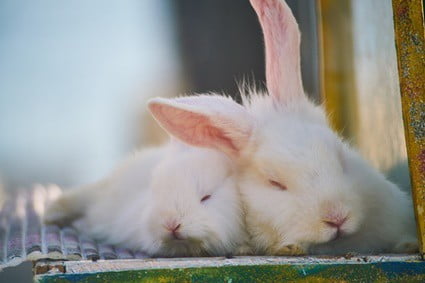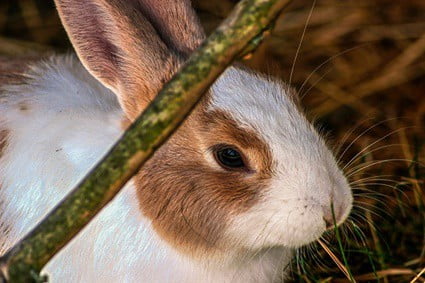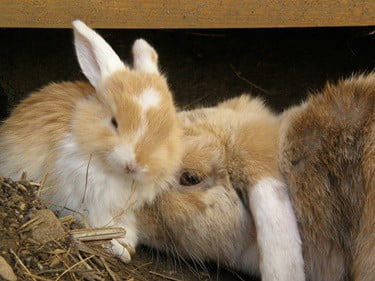A doe only feeds her kits 2 times a day, and each feeding session will only be a few minutes long. It may look like a doe is ignoring her litter, but this is perfectly normal. It is made possible because the milk from a rabbit is more concentrated in nutrients and calories than other types of mammal milk. There are ways to increase the doe’s milk production when there are clear signs that the kits are being underfed.
Rabbit kits drink milk from the doe twice a day. Kits will continue to drink milk from the doe up until they are fully weaned at between 6-8 weeks of age. Increasing milk production in the doe to meet this demand relies on her diet. A lactating doe should have free access to water and food. This includes fresh vegetables, pellets, and grass hays.
Alfalfa hay should also be offered for increased calcium and protein, which will benefit the doe and kits. Providing a secure and quiet environment for the doe to nest in will also prevent any stress-related issues in milk production. Poor nutrition, health issues, and a lack of food can cause milk production to be lessened or ceased entirely.
Do Baby Rabbits Drink Milk from Their Mother?
A female rabbit has mammary glands that produce milk for her young. This milk will be the only sustenance that rabbit kits ingest during their first fragile weeks of life. Kits will suckle the milk from the mother’s teats. Aside from providing nutrition and hydration, this milk is the only food rabbit kits can safely consume.
Kits’ intestines are sterile, meaning that they do not have established gut flora colonies. These colonies aid in breaking down food. Importantly, they also prevent harmful bacteria and parasite populations from growing to dangerous levels. A doe’s milk also contains colostrum, a substance full of antibodies that prevent harmful bacteria from growing.
The Spanish Journal of Agricultural Research notes the vital role that gut bacteria play in protecting weaned rabbits from epizootic enteropathy. This is a severe gastrointestinal disease that carries a 30%-80% mortality rate without treatment. This is seen in rabbit kits that are weaned too early.
Rabbit kits will begin eating their mother’s fecal pellets as a means for both beginning the weaning process, and establishing their own healthy gut flora colonies.
How Long Do Baby Rabbits Need Milk?
A doe will feed her kits twice a day. Once in the morning and once at night, usually. This will continue up until the kits are 8 weeks old. They should not be separated from the mother until after 8 weeks, even if weaned. This is because the kits will still need to eat the doe’s fecal and cecotropes pellets.
Kits will live solely off of the doe’s milk for the first 2-3 weeks. At this point, the kits will begin nibbling on the doe’s fecal pellets and regular food. Over the next few weeks, the kits will continue to drink from the doe while also eating pellets and food. It is critically important that kits still drink the doe’s milk at this stage. The colostrum will keep the gut flora colonies in check, while the kits gradually incorporate more solid foods into their diets.
Kits will usually be fully weaned around 6-8 weeks of age, which is also when the doe will stop producing milk. In the event that the doe cannot adequately nurse the kits, or she has died, you will have to make rabbit kit formula. This is a bit of a process, as there is no commercial rabbit formula in the U.S.

When Do Pregnant Rabbits Get Milk?
A rabbit will begin lactating once she has given birth. She will, however, not produce as much milk as you might expect. This works in her favor. A doe’s milk is 2-3x more concentrated than cow’s milk. This allows her to reduce the frequency of feedings and the amount of milk she has to produce. In the wild, this would enable a doe to spend more time foraging for food.
During the first week after giving birth, the doe’s milk production may be quite low. She should be able to produce enough to keep the kits alive. After this week, her milk production should be providing plenty of food for her kits. Each feeding session for the kits is only a few minutes long.
Rabbit Not Producing Enough Milk
There are a few signs that a doe isn’t producing enough milk. The main one is the state of the kits. Be sure to wash your hands before handling any kits for inspection, and cover your hands in the doe’s scent as well.
Healthy, well-fed rabbit kits should have plump bellies, be warm to the touch, and not have wrinkly skin. Well-fed kits will also be calm and restful. You may even be able to see their milk-filled stomachs through the semi-translucent skin over their bellies.
Rabbit kits that are underfed will have shrunken bellies, wrinkled, blueish skin, and may be crawling around, seeking the doe. If the kits also try to feed every time the doe enters the nest, then they may not be getting enough milk. Carefully watch how the kits react to the doe’s presence.
It is important to determine why the kits are underfed. Here are questions to consider:
- Is the doe not producing enough milk?
- Is she producing any milk at all?
- Did she have an unusually large litter?
- Is something limiting her milk production?
- Is she refusing to feed the kits?
- Does she feel safe and secure enough to feed the kits?
Reduced or No Milk Production
It is not unusual for a doe to not produce the maximum amount of milk possible during the first few days after giving birth. Still, a doe should be able to make enough to keep the kits healthy and from starving.
It’s key to act quickly during the first 2 days after birth. Kits can go up to 72 hours without feeding, but this isn’t the only reason why acting quickly matters.
A method for kick-starting a doe’s milk production is to take her to the vet for a shot of oxytocin. This is the hormone that is activated during birth and is responsible for beginning lactation. You may also have heard oxytocin referred to as the loving hormone. A dose of oxytocin will only work for up to 48 hours after the birth, which is why you need to act quickly.
As for reduced milk production, a lack of food or water can cause the doe to produce less milk.
Large Litter
Large litters can pose an issue, as the doe may literally be unable to create enough milk to feed all the kits. Domestic rabbits have an average litter size of 5 kits. However, a doe can have up to 14 kits in a single litter. Depending on how many mammary glands a doe has, it may become ‘first come, first serve’ with the kits.
Naturally, the most well-fed kits will become stronger and able to push their weaker siblings to the side. Unless the doe specifically allows all of the kits a chance to feed, some kits may become underfed.
Health
A doe may literally be unable to lactate due to health reasons. There are many health issues that can afflict rabbits. Carefully observe the doe for any concerning symptoms, and take her to the vet if any arise.
You can also verify if the doe is lactating by checking the mammary glands. They should be swollen with milk. A small amount of liquid should leak from the teat if you apply gentle pressure on either side of it.
If the kits themselves are sickly, she may also reject the litter and refuse to feed them. Sad as it is, this is the doe conserving her energy for the next litter and increasing their chances of survival. Keep the doe calm and place her in the nesting box. Watch how she interacts with the kits, if at all, and if she is willing to nurse.
Diet
The main reason why a doe may be lacking in milk production is an improper diet. A nursing doe will eat much more than non-nursing rabbits. A lack of food will prevent the doe from producing milk.
The doe may suffer health complications if she isn’t provided with enough high-quality food. A doe’s body will literally begin stripping the calcium from her bones to make milk if her diet lacks in nutrition.
Security
A doe that doesn’t feel safe feeding her kits will avoid feeding sessions, or may end sessions prematurely. Stress may wreak havoc on a rabbit’s internal systems, including those responsible for milk production. Stress can also override a doe’s need to care for her litter.
A doe will need a quiet, secure place for her nests. Ideally, this means an enclosure or sealed room where no other pets can enter. The less foot traffic in this room, the better.
How To Increase A Rabbit’s Milk Supply
Ensure that she has plenty of high-quality food. A lactating doe should have free access to food and water all day, as her body is working double-time to produce milk. If she doesn’t have enough food, or the food lacks nutrients, her body will begin consuming itself to keep up milk production.
Nursing does should be given fresh hay every day like normal. However, you can temporarily offer alfalfa hay as well for extra calcium and protein. Doing this ensures that the doe is getting enough calcium for both herself and her milk, which also benefits the growing kits. Lots of grass hay also means fiber, which will keep her gastrointestinal tract moving.
Fresh vegetables and herbs are also a must. These should already be a regular part of your rabbit’s daily diet. Still, it is beneficial to offer extra vegetables and herbs to your rabbit on top of its usual fare. You may even try splitting the food into two separate feeds, so that the food is fresh.
Obviously, the doe should always have access to clean water as well. Milk has a great deal of water content. A dehydrated doe will produce less milk, which can also lead to dehydrated kits.
Increasing a doe’s milk production also requires providing her with a comfortable and secure place to nest. As the Veterinary Nursing Journal states, stress causes rabbits to produce catecholamines, which hamper and stop gut motility. When food stops being processed by the rabbit’s body, which should be near constantly, it won’t be able to produce milk either.
What To Feed A Nursing Mother Rabbit
Nursing rabbits and their kits benefit greatly from high-quality food. You can provide higher quality pellets, and slightly increase the doe’s daily serve of pellets. Ideally, the food quantities that should be increased are the grass hay and the fresh vegetables and herbs.
Normally, the ratio of fresh vegetables and herbs is 9 ounces per 2 pounds of bodyweight. While nursing, you should ignore this ratio and ensure that the doe has free access to fresh food. That is, on top of lots of fresh hay, which can be cut with special alfalfa hay for more protein and calcium.
If not already, consider including the following vegetables and herbs in your rabbit’s diet in preparation for gestation and nursing:
- Cabbage
- Broccoli
- Beetroot tops
- Carrot tops
- Spinach
- Watercress
- Bok choy
- Romaine lettuce
- Rocket
- Chicory
- Kale
- Mustard greens
- Parsley
- Dandelion
- Coriander
- Dill
- Coriander
- Basil
Including these foods in the doe’s diet not only ensures that she is getting enough food, but improves the quality of the milk she produces. The more nutrients in her diet, the more nutrients her body can infuse into the milk.
Always move with caution when introducing new foods into your rabbit’s diet, even temporarily. Gradually add new foods to the doe’s diet amidst her usual food and watch for any issues with digestion. Ideally, these foods should be introduced into the rabbit’s diet before she’s even pregnant. We really would not recommend making big changes at this time either.

How To Make Rabbit Milk Replacer
There comes a time when nothing can be done. The doe isn’t producing milk, or has unfortunately passed, and the kits need to feed. This is when you need to make a rabbit milk replacer. That is not an easy thing to accomplish.
Rabbit milk replacer can also be useful if the doe isn’t producing enough milk. You can supplement her milk by doing additional feedings with the formula. This keeps the kits in top shape, and also ensures that all are hydrated and fed.
At this point in time, there is no direct man-made rabbit milk formula available in the U.S. You will have to create your own using kitten milk replacer and goat’s milk as a base, not cow’s milk.
You will also need to source fresh pellets and cecotropes made by a healthy rabbit. The kits will need to eat these to establish the essential gut bacteria colonies to safely make the transition from milk to solid foods.
Hand-raising rabbit kits is an arduous duty, and the chances for survival are not great. One source we came across suggested finding a rabbit rescue or breeder willing to foster the kits. They may have a mother willing to surrogate the kits, which will improve their odds of survival.
Homemade Rabbit Milk
You must use whole goat’s milk and kitten milk replacer as the base formula. You will also need to add colostrum and heavy cream to the mix. Rabbit milk is high in calories and very rich. Your homemade rabbit milk needs to match the nutrient and calorie content to keep the kits healthy. Make your own rabbit milk formula by:
- Taking ½ a cup of goat’s milk
- With ½ a cup of kitten milk replacer formula (or an equal amount of pre-made kitten milk).
- To this mixture, add ½ a teaspoon of heavy cream
- And 1 tablespoon of colostrum powder.
- Warm the mixture gently and stir until the colostrum has fully dissolved.
This formula can be made in advance and reheated as needed. We would still recommend making a fresh batch every day and discarding any unused formula.
Colostrum powder can be purchased from vets and pet supply stores, especially those that specialize in small mammals.
If your rabbit doe isn’t producing enough milk, you can improve her diet and reduce her stress to help. However, the best approach is to be preemptive. If you know your rabbit is about to give birth, provide her with a safe, quiet place to care for the litter. Likewise, check over her diet to ensure she’s receiving all the nutrients she needs.


Everything I’ve read in the past says mint inhibits milk production in rabbits…